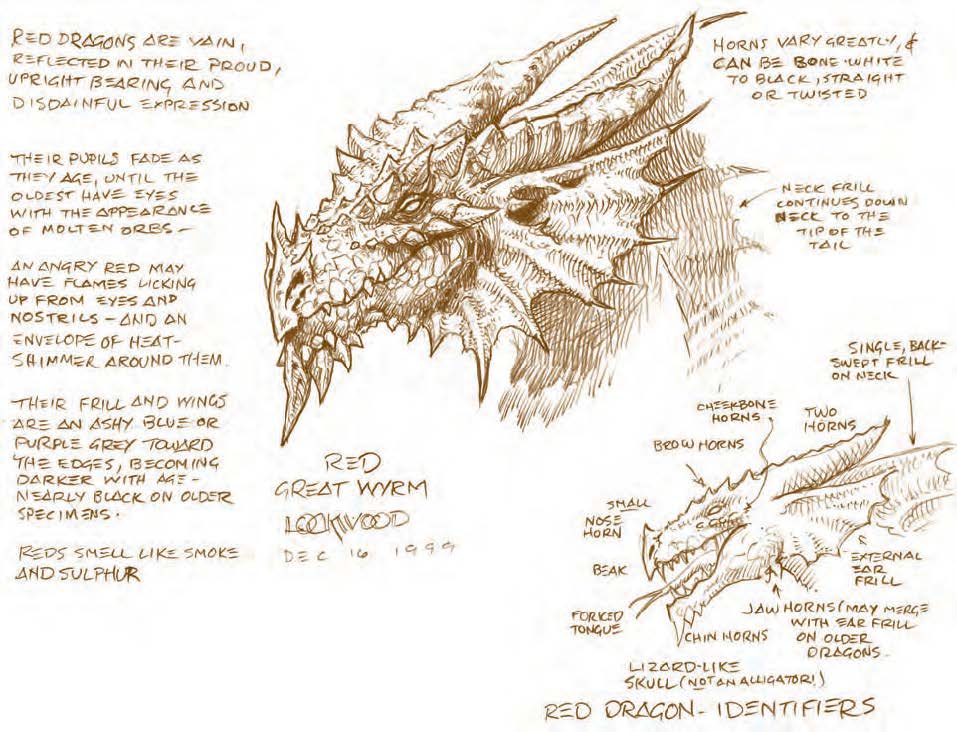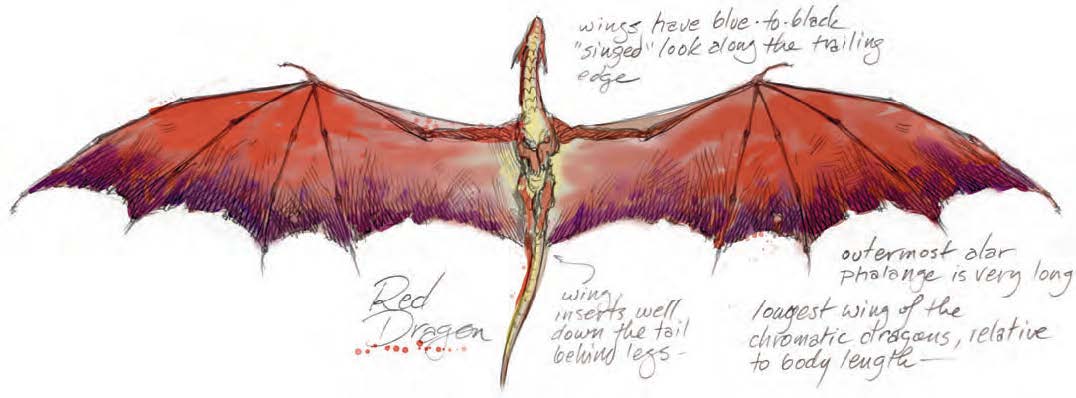Red Dragon
The most covetous of all true dragons, red dragons tirelessly seek to increase their treasure hoards. They are exceptionally vain, even for dragons, which is reflected in their proud bearing and disdainful expression.
Red dragons love mountainous terrain, but also inhabit hilly regions, badlands, and other locales where they can perch high and survey their domain. Their preference for mountain homes often brings them into conflict with silver dragons, which red dragons passionately hate. Silver dragons usually get the better of red dragons in battle, which merely serves to stoke the flames of resentment among red dragons. Red dragons also vie for territory with copper dragons from time to time, and the weaker copper dragons are often hard-pressed to survive any direct confrontation.
A red dragon seeks out a large cave that extends deep into the earth for its lair. Caves with some kind of volcanic or geothermal activity are the most highly prized. No matter what its lair is like, however, the dragon always has a high perch nearby from which to haughtily survey its territory.
Dungeon-dwelling red dragons seek out superheated or fiery areas for their lairs. Since dungeons usually lack elevated areas that offer panoramic views of the neighborhood, red dragons living in such places often settle for open spaces or areas with long corridors that offer broad views.
Red Dragon Identifiers
Two massive horns sweep back atop a red dragon’s head. These horns can be straight or twisted, and can be any hue from bone white to night black. Rows of small horns run along the top of a red dragon’s head, and the dragon has small horns on its cheeks and lower jaw as well. A red dragon has a beaked snout with a small nose and chin horns. Its tongue is forked, and little flames often dance in its nostrils and eye sockets when it is angry. The dragon has fringed ears that tend to merge with the cheek horns as the dragon ages. A red dragon’s teeth protrude when its mouth is closed, and it has a single backswept frill that begins behind the head and runs all the way to the tip of the tail. The small scales of wyrmlings are a bright glossy scarlet. Toward the end of the young stage, the scales turn a deeper red, and the glossy texture is replaced by a smooth, dull finish. As the dragon grows older, the scales become large, thick, and as strong as metal. The pupils of a red dragon fade as it ages; the oldest red dragons have eyes that resemble molten lava orbs. The odor of sulfur and pumice surrounds a red dragon. A red dragon has the longest wings of all chromatic dragons, both in actual measurement and in relation to body length. This is mostly due to the outermost alar phalange, which is very long and gives the wing a tapering look. The longest part of the wing is right at the trailing edge. The trailing edge of the wing membrane attaches to the dragon’s body behind the rear lags and well down the tail. The wings have a bluish or blue-black tint along the trailing edge (the dragon’s frills show a similar pattern the color resembles metal burned blue in a fire. The great horns on a red dragon’s head are clearly visible from below.Habits
Red dragons are so rapacious, ferocious, vengeful, and avaricious that scholars regard them as the archetypical evil dragons. Red dragons share this opinion of themselves. They believe that, above all other species, they are closest to the ideals of draconic nature and behavior, and that the rest of dragonkind has slipped from this purity. Younger red dragons often find life difficult. Their vivid red scales make them dangerously conspicuous in most landscapes, and so they lurk underground by day and venture forth only at night. Older red dragons, however, are both less vividly colored and more aware of their presumed status as the epitome of dragonkind. Red dragons are the most obsessive treasure collectors among the true dragons. They covet absolutely anything of monetary value and often can judge a bauble’s worth to within a copper piece with just a glance. Every red dragon knows the exact value of items in its hoard, along with exactly how and when the dragon obtained the item and each item’s exact location in the hoard. Bards tell tales of sneak thieves who ignite a dragon’s wrath just by stealing a single trinket. Such tales are firmly grounded in fact, at least where red dragons are concerned. In some cases, in fact, the tales fall short of the mark. An adult red dragon can notice a single coin missing from its hoard, and its rage over the pettiest theft is legendary. The dragon tracks down and slays the thief if possible. If not, the dragon is sure to go on a rampage, killing anything it meets and laying waste to any town or village where the thief might have taken refuge. All red dragons are solitary by nature and fiercely territorial; they keep constant watch for trespassers of any kind and for encroachment by other dragons. Entering a red dragon’s territory uninvited is asking to be attacked. For all their ferocious independence, however, red dragons always seek to know about events in the wider world. They often make use of lesser creatures as informants, messengers, and spies. The dragons invariably adopt patronizing attitudes toward these servants, and do not hesitate to slay and eat them when they bring bad news. A red dragon is particularly interested in news about other red dragons, mostly because its own status relative to its peers remains a top concern. A red dragon’s pride is easily wounded, because any defeat or insult left unanswered causes a loss of status. This is one reason why red dragons are prone to destructive rages. A red dragon usually can recover some lost status by wreaking havoc. Every red dragon firmly believes that no being deserves to keep anything it is not strong enough to defend. Red dragons apply this rule to their own kind. Occasionally, reddragons perceive weakness among one of their own, and the subject is not allowed to live. The victim is attacked, and its lair is stripped. Courtship among red dragons can be a perilous affair, because most would-be suitors are treated as dangerous rivals. Successful red dragon courtship usually involves a younger dragon with fairly high status among its peers carefully approaching an older one. Females do most of the courting, but males are also known to do so. After mating, the younger dragon is usually left to guard the eggs. Most red wyrmlings are left to fend for themselves. Occasionally, two parents of about equal age mate and tend their young together. Red dragons rarely fight for mates. Most are wise enough to know that any battle will be fatal, and prudently quit the field when a superior rival makes a claim. Red dragons are meat-eaters by preference, and their favorite food is a human or elf youth. Their taste for the flesh of young women is well documented. The dragons steadfastly claim that such meat simply tastes better. Sometimes they force villagers into regularly sacrificing maidens to them. Red dragons are confident fighters for whom retreat or compromise is not an option. They spend years formulating plans of attack; upon spotting potential foes, they simply choose a strategy and immediately put it into practice. Being swift but not particularly agile flyers, they often choose to fight on the ground when they can. There, red dragons often display considerable mobility and tactical savvy. They are excellent jumpers, and often leap from place or take short flights to gain the most favorable position possible when using spells or breath weapons. Any red dragon is well aware that its fiery breath can destroy treasure, and it uses its breath weapon judiciously so as to avoid incinerating the spoils of victory. For all its legendary ferocity, a red dragon also knows when not to attack. If it recognizes a superior foe, it (reluctantly) withdraws to fight another day if it can do so without losing face. Likewise, when dealing with a clearly weaker foe, a red dragon might attempt to bully or fool the creature into rendering it some service or supplying information. In either case, the dragon gets what it wants, or the creature dies. The dragon will accept no other outcomes. Red dragons do not slay every foe they meet in battle. Always conscious of status, they often allow a few survivors to escape and spread word of the dragon’s victory.Sources:
- Dungeons & Dragons Draconomicon (3.5 Edition, 2009).
- Monster Manual, Red Dragon
Related Ethnicities




Comments